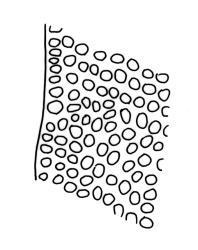- ≡ Orthotrichum microstomum Hook. & Grev., Edinburgh J. Sci. 1: 114 (1824)
- = Macromitrium weymouthii Broth., Öfvers. Finska Vetensk.-Soc. Förh. 37: 161 (1895)
- = Macromitrium flaccidisetum Müll.Hal., Hedwigia 37: 147 (1898)
Plants slender, dull or lustrous, mostly olive-green or dark yellow-green above, darker and brown or olive-green below. Branches 4–12(–15) mm, ascendant, simple or forking below sex organs. Stem leaves flexuose-twisted when dry, recurved-twisted when moist, ovate-lanceolate, gradually contracted to acuminate-subulate apices, 1.2–1.5 mm. Branch leaves strongly spiralled around the branch, irregularly twisted, and with apices incurved or decurved when dry, weakly to strongly funiculate and erect to erect-spreading when moist, ligulate to ligulate-lanceolate, ± acute, strongly keeled throughout, with a single plication below on one side, 1.2–2.0 mm; margins entire, plane above, recurved on one side below; upper laminal cells mostly rounded and isodiametric but some usually oblate, firm-walled, flat, smooth, unistratose, c. 8–10 μm wide (lumina 5–8 μm wide); mid laminal cells elliptic to rectangular, thick-walled and smooth, with straight lumina, 10–20 × 8–10 μm (lumina c. 6 μm wide); inner basal cells elongate-rectangular, evenly thick-walled or slightly nodose, with ± straight lumina, smooth, (18–)24–55 × 7–8 μm (lumina 2–4 μm wide); marginal basal cells not nodose, not forming a distinct border. Costa slender and curving weakly to one side above, ending in or a few cells below the leaf apex, the abaxial superficial cells elongate throughout, in cross-section with 2–3 guide cells and 2–4 abaxial layers of poorly differentiated stereids. Gemmae absent.
Autoicous. Perichaetial leaves ± straight and weakly sheathing the setae, oblong-lanceolate to ovate-oblong, narrowly acuminate-cuspidate, 1.5–2.1 mm. Perigonia bulbiform, terminal on short branches, often a short distance below the perichaetium. Setae (3–)4–18 mm, smooth, ± straight or flexuose, slender, sinistrorse; capsules narrowly ovate to oblong, smooth, usually sharply narrowed to a puckered, 8-plicate, and darker mouth, 1.0–1.7(–1.9) mm; exothecial cells thick-walled, irregular in outline and size, shorter, darker, and thicker-walled near rim; stomata, annulus, and operculum as per genus. Peristome single; exostome teeth 16, pale, inflexed when dry, narrowly lanceolate, finely and evenly papillose on inner surface, coarsely papillose on transverse striae of outer surface, c. 180 μm. Calyptra tightly clasping the developing capsule, c. 2–2.5 mm, usually not deeply lacerate, mitrate or cucullate, plicate, naked. Spores isosporous, 30–54 μm diam., thick-walled, irregularly papillose.
Vitt 1983, figs 52–61, 63–68; Vitt 1994, fig. 470; Vitt et al. 1995, fig. 21 a–j.; Meagher & Fuhrer 2003, p. 69.
Macromitrium microstomum is likely to be confused only with its ally M. longipes, but the two species differ in many ways, including size, colour, the nature of their lower laminal cells, perichaetial leaf shape, and sexuality. Macromitrium microstomum is a smaller, olive-green plant, with branches usually less than 12 mm and branch leaves 1.2–2.0 mm, while M. longipes is a larger, distinctly chestnut-coloured plant, with branches often c. 20–30 mm and branch leaves 1.5–3.0 mm. In M. microstomum, the middle laminal cells of branch leaves have straight or only slightly curved lumina, and a rather abrupt transition between upper and basal cells, while in M. longipes the lumina are strongly S-shaped, and the transitional area is much larger. In M. microstomum the perichaetial leaves have a fine, delicate, and flexuose point, while in M. longipes these leaves are broadly and sharply acute and stiffly erect. Macromitrium microstomum is autoicous with the perigonia bulbiform and often conspicuous (but variable in size) at the tips of short branches near the perichaetia. Vitt (1983, p. 29) discussed other features that distinguish the two species, and the variability of seta length and leaf shape found in M. microstomum.
NI: N Auckland (near North Cape, near Mangōnui, near Warkworth), S Auckland, Gisborne, Hawke’s Bay, Taranaki (Mt Taranaki), Wellington; SI: Nelson, Marlborough (s. loc.), Canterbury, Westland (Ōtira), Otago, Southland.
Anomalous (more or less pantropical but extending to temperate latitudes in Australasia). Tasmania*, mainland Australia*, Pacific Islands including Hawai‘i, Java, New Guinea, Borneo, and Central America (fide Vitt & Ramsay 2006).
Vitt (1983) considered this species to be "infrequent" north of the latitude of Hamilton. The paucity of collections from Taranaki L.D. is perhaps a collection artefact. The species appears to be genuinely infrequent in the drier regions of the South I.
Epiphytic on canopy branches and less often on tree trunks in areas of higher rainfall and on scrub vegetation at tree line. While Vitt (1983) considered it to be abundant in montane rain-forest dominated by southern beech, M. microstomum is generally less abundant than M. longipes in such forests. Occurring from near sea level (e.g., near Carterton, Wellington L.D.) to c. 1200 m (Mt Ruapehu, Wellington L.D.) on the North I. The highest confirmed South I. elevation is c. 990 m (Hope Range, Nelson L.D.).
In addition to species of southern beech (Fuscospora fusca, F. solandri s.l., and Lophozonia menziesii), this species occurs on the native woody dicots Aristotelia serrata, Coprosma spp., Dracophyllum spp., Gaultheria sp., Kunzea ericoides, Leptospermum scoparium, Olearia nummularifolia, and Weinmannia racemosa as well as podocarps (e.g., Lepidothamnus intermedius and Podocarpus totara). It has also been recorded from Quercus sp. (at Rotorua). Associated species include Dicnemon calycinum, D. semicryptum, Hampeella alaris, Leptostomum inclinans, Macromitrium grossirete, and M. longipes.
Macromitrium microstomum is placed by Vitt & Ramsay (1985) in their "M. microstomum group". The other species placed here are the N.Z. endemics M. longipes and M. orthophyllum, as well as four eastern Australian endemics.
The combination of smooth (non-papillose), flat upper leaf cells and a distinctly funiculate leaf set distinguishes M. microstomum and M. longipes from all other N.Z. species of Macromitrium. The funiculate appearance of the branches, with each leaf twisted on itself and positioned in a spiral insertion, is usually quite evident, but is sometimes more obvious when the plants are moist.











